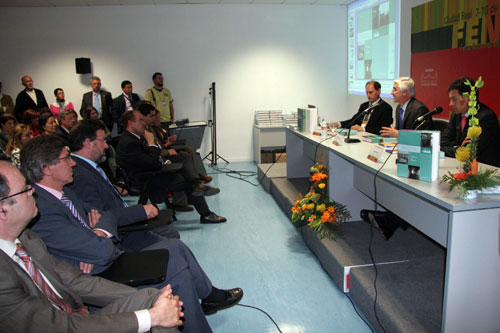Ciudad Real
May 6 - 8, 2025

09
may 2007
This afternoon at the National Trade Fair on Wine the Architect Diego Peris, Director of the Infrastructure Management Bureau of the University of Castilla-La Mancha (UCLM), has presented the book "Arquitectura y cultura del vino en Castilla-La Mancha". At the event José María Barreda, President of the Autonomous Community, companied him; this book presents a reality of exceptional importance that has configured the region's architecture and landscape. Nemesio de Lara and Ángel Amador, respectively President and Institutional Coordinator of FENAVIN, were also present at the event.
Barreda, prior to referring to the work and to Peris, indicated that whenever he listens to the opinion of an exhibitor and, even to the opinion of Josep Puxeu, Secretary General of the Ministry of Agriculture, likewise present at the event, about the trade fair he feels more than satisfied, "because FENAVIN is truly a wonderful idea, as we already highlighted on the day of its inauguration".
Barreda commented that for Castilla-La Mancha wine represents a strategic sector, with much social, historical, cultural and environmental importance. "It moves vast amounts of money and its importance is truly great. It is important from both a social point of view, as well as a demographic", he added.
Concerning the book, Barreda highly recommended it. "The general public is going to like it, but the sector in particular is going to love it, because all the wineries are covered. And there is even a chapter dedicated to design in the world of wine", he commented.
On his part Peris, during the presentation of his book, led the audience along a trip through the industrial architecture, of an important heritage value. In which apart from its descriptive part, the intention is to make us think about the need there is to take good care of the 'winery' space, inside and out, as a value of image and brand, apart from appreciating these constructions that, along with the vineyard, define the landscape and the historic and human reality of Castilla-La Mancha.
The book starts with an analysis on the social, economic and cultural importance of the Castilian-Manchego viticulture reality and on the architecture it has generated. The vine, the territory and time, the vineyards of La Mancha and the denominations of origin are the first three chapters of this first part that structure information covering the relevance of wine in this region.
As of this introduction the book takes us on a journey through Castilla-La Mancha, following the route of the denominations of origin: Almansa, Jumilla, La Mancha (in its areas corresponding to the provinces of Albacete, Ciudad Real, Cuenca and Toledo), Manchuela, Méntrida, Mondéjar, Ribera del Júcar, Uclés and Valdepeñas. 'Pago' wines (premium quality wines) are presented in the book's final section, following the denominations of the specific winery estates that exist in Castilla-La Mancha (Guijoso, Finca Élez, Dehesa del Carrizal and Dominio de Valdepusa).
The journey individually covers each municipality, describing the wineries and their architecture in each one of them, along with the structures that have been constructed and their organization in the urban environment. Each one of the wineries is placed in the context of the cities in which they are found, analyzing their reality and historic evolution. In most photographs of the wineries accompany the description; and in some singular cases a map of the same is included, given that these are historical buildings or wineries with significant current-day vanguard architecture.
Thus almost two-hundred wineries are covered, of very different characteristics: the ancient historical wineries, constructions dating from the end of the 19th century, the boom experienced by the cooperatives in the mid 20th century and modern current-day constructions, whether the same correspond to industrial architectures or to 'Pago' wineries related with the estates on which they are found. The remarkable situation of those wineries that are inserted in the city find an exceptional example in Valedepeñas, in which the city map is studied with the inclusion of the wineries in the same. The two final chapters briefly cover other extraordinary constructions -such as the Wine Museum of Valdepeñas- with the book finishing off with an analysis of the theme on wine design.
We use our own and third-party cookies to manage the website, obtain information about its use, improve our services or to show you advertising according to your preferences. You can click on ACCEPT, to allow the use of all cookies, or on settings to see the cookies in detail and indicate which ones you want to accept or reject. +info
Settings